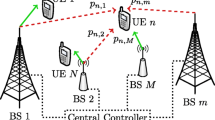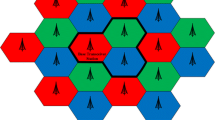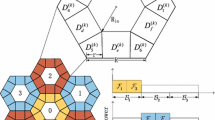Abstract
In LTE-Advanced, the same spectrum can be re-used in neighboring cells, hence coordinated scheduling is employed to improve the overall network performance (cell throughput, fairness, and energy efficiency) by reducing inter-cell interference. In this paper, we advocate that large-scale coordination can be obtained through a layered solution: a cluster of few (i.e., three) cells is coordinated at the first level, and clusters of coordinated cells are then coordinated at a larger scale (e.g., tens of cells). We model both small-scale coordination and large-scale coordination as optimization problems, show that solving them at optimality is prohibitive, and propose two efficient heuristics that achieve good results, and yet are simple enough to be run at every transmission time interval. Detailed packet-level simulations show that our layered approach outperforms the existing ones, both static and dynamic.




























Similar content being viewed by others
Notes
One method to deal with interference measurement is reported in [31], Chapter 15.2: a set of neighboring cells can be configured to transmit either a non-zero- or a zero-power Reference Signal (RS), hence one can measure the interference with/without transmission from that set of cells. RSs are transmitted using Resource Elements in the Physical Downlink Shared Channel. As more cells are added to the set, more RSs are required, which increases the overhead.
Multi-user Multiple-Input/Multiple-Output (MIMO) techniques are outside the scope of this paper.
We leave out techniques such as joint processing, whereby two cells target the same UE simultaneously, reinforcing the useful signal.
This problem can be reformulated as a mixed-integer-linear problem (MILP), through a careful reformulation (omitted for the sake of conciseness), but only at the price of increasing the number of variables to O(2^(2K)).
References
3GPP—TS 36.300. Evolved Universal Terrestrial Radio Access (E-UTRA) and Evolved Universal Terrestrial Radio Access Network (E-UTRAN); Overall description; Stage 2.
3GPP—TR 36.819 v11.2.0. (2013). Coordinated multi-point operation for LTE physical layer aspects (Release 11).
Lee, D., Seo, H., Clerckx, B., Hardouin, E., Mazzarese, D., Nagata, S., et al. (2012). Coordinated multipoint transmission and reception in LTE-advanced: Deployment scenarios and operational challenges, IEEE Communications Magazine, pp. 148–155
China Mobile Research Institute. (2011). C-RAN - The Road Towards Green RAN, v. 2.5 white paper.
3GPP—TS 36.211 v12.4.0. (2014). Evolved Universal Terrestrial Radio Access (E-UTRA); Physical channels and modulation.
3GPP—TS 36.213 v12.4.0. (2014). Evolved Universal Terrestrial Radio Access (E-UTRA); Physical layer procedures.
Pateromichelakis, E., Shariat, M., ul Quddus, A., & Tafazolli, R. (2012). On the evolution of multi-cell scheduling in 3GPP LTE/LTE-A, IEEE Communications Surveys and Tutorials.
Rahman, M., & Yanikomeroglu, H. (2010). Enhancing cell-edge performance: a downlink dynamic interference avoidance scheme with inter-cell coordination. IEEE Transactions on Wireless Communications, 9, 1414–1425.
Virdis, A., Stea, G., & Nardini, G. (2014). SimuLTE: A modular system-level simulator for LTE/LTE-A networks based on OMNeT++, proc. of SimulTech 2014, Vienna, AT, 28–30 August 2014
SimuLTE webpage. http://www.simulte.com
OMNeT++, http://www.omnetpp.org
Sternad, M., Ottosson, T., Ahlen, A., & Svensson, A. (2003). Attaining both coverage and high spectral efficiency with adaptive OFDM downlinks, Proc. of VTC 2003-Fall, pp. 2486–2490 6–9 October 2003.
3GPP. (2005). Soft frequency reuse scheme for UTRAN LTE, 3rd generation partnership project (3GPP), R1-050507.
Fang, L., & Zhang, X. (2008). Optimal fractional frequency reuse in OFDMA based wireless networks, Proc. WiCOM ‘08, pp. 1–4, 12–14 October 2008.
Ali, S. H., & Leung, V. C. M. (2009). Dynamic frequency allocation in fractional frequency reused OFDMA networks. IEEE Transactions on Wireless Communications, 8(8), 4286–4295.
Hoon, K., Youngnam, H., & Jayong, K. (2004). Optimal subchannel allocation scheme in multicell OFDMA systems, Proc. of VTC Spring’04 pp.1821–1825 Vol.3, 17–19 May 2004.
Li, G., & Liu, H. (2006). Downlink radio resource allocation for multi-cell OFDMA system. IEEE Transactions on Wireless Communications, 5(12), 3451–3459.
Koutsimanis, C., & Fodor, G., (2008). A dynamic resource allocation scheme for guaranteed bit rate services in OFDMA networks, Proc. ICC ‘08, pp. 2524–2530, 19–23 May 2008.
Arslan, M. Y., Yoon, J., Sundaresan, K., Krishnamurthy, S. V., & Banerjee, S. (2013). A resource management system for interference mitigation in enterprise OFDMA femtocells. IEEE/ACM Transactions on Networking, 21(5), 1447–1460.
Khun, H. W. (1955). The Hungarian method for the assignment problem. Naval Research Logistic Quarterly, 2, 83–97.
3GPP TR 36.814 v9.0.0. (2010). Further advancements for E-UTRA physical layer aspects (Release 9).
http://www-tkn.ee.tu-berlin.de/research/trace/pics/FrameTrace/mp4/index6e27.html
Bacioccola, A., Cicconetti, C., & Stea, G., (2007). User level performance evaluation of VoIP using ns-2, Proc. NSTOOLS’07, Nantes, France, 22 October 2007.
Nardini, G., Stea, G., Virdis, A., Caretti, M., & Sabella, D., (2014). Improving network performance via optimization-based centralized coordination of LTE-A cells, Proc. of CLEEN 2014, Istanbul, TK, 6 April 2014
Nardini, G., Stea, G., Virdis, A., Sabella, D., & Caretti, M. (2014). Effective dynamic coordinated scheduling in LTE-Advanced networks, Proc. of EuCNC 2014, Bologna, Italy, 23–26 June 2014
INET framework for OMNeT++: http://inet.omnetpp.org/ (Accessed July 2014)
3GPP TR 36.420 v11.0.0. (2012). X2 general aspects and principles (Release 11).
Accongiagioco, G., Andreozzi, M. M., Migliorini, D., & Stea, G. (2013). Throughput-optimal resource allocation in LTE-advanced with distributed antennas. Computer Networks, 57(2013), 3997–4009.
Stea, G., & Virdis, A. (2014). A comprehensive simulation analysis of LTE discontinuous reception (DRX). Computer Networks, 73(2014), 22–40. doi:10.1016/j.comnet.2014.07.014.
EARTH EU project website, https://www.ict-earth.eu/
Dahlman, E., Parkvall, S., & Skold, J. (2014). 4G LTE/LTE-Advanced for Mobile Broadband, 2nd ed.
Acknowledgments
The subject matter of this paper includes description of results of a joint research project carried out by Telecom Italia and the University of Pisa. Telecom Italia reserves all proprietary rights in any process, procedure, algorithm, article of manufacture, or other result of said project herein described. Authors would like to thank Prof. Antonio Frangioni and Dr. Laura Galli of the University of Pisa for their useful suggestions.
Author information
Authors and Affiliations
Corresponding author
Appendix
Appendix
We provide here a formal description of the algorithms run in Step 2 of the SSC. The bid composition algorithm is reported in Fig. 29. For each inequality in (2), we compute the exceeding RBs (lines 1–3). We then scan the inequalities and decrease the bids that appear in each of them (line 9), until the excess of the inequality is nullified. Since a bid appears in more than one inequality, the excesses must be updated (lines 15–16). By scanning the inequalities by decreasing order of their excess (line 4), the number of required iteration is in general smaller, as it is more likely that fixing those with larger excesses first will make some other inequalities hold as well.
Once the bids have been composed, we can define the ILSs. With reference to the pseudo-code in Fig. 30 we denote the size of an ILS as Δ(x), where x is the set of active cells in that ILS. Double-muting ILSs are easily defined (line 1). Since the size of single- and no-muting ILSs is defined as the maximum among the requests from neighboring cells, there may be unused RBs in each subframe. Starting from the single-muting ILSs, for each cell we compute the size of the (possibly two) unassigned areas (lines 3–4) and fill them with as many RBs as possible from the no-muting bid (lines 5–10). Then, the size of single-muting ILSs is defined as the minimum between the corresponding bids (line 14), while their difference is added to the double-muting ILS of the cell that requested more RBs (lines 15–17). Similarly, no-muting ILS is defined as the minimum among the no-muting bids (line 19) and the excesses are redistributed to single- and double-muting ILSs (lines 20–23). According to this procedure, some of the single-muting RBs will be upgraded to double-muting, and some of the no-muting RBs will be upgraded to either double-muting or single-muting.
Finally, if there are enough unallocated RBs, we can transform one no-muting RB into three double-muting RBs. With reference to the pseudo-code of Fig. 31, given the number of unallocated RBs (line 1), we compute the amount of RBs that can be moved to double-muting, taking into account that one no-muting RBs will become three double-muting RBs (line 2). That amount of RBs is carved from the no-muting ILS (line 3) and added to double-muting ILSs of the three cells proportionally, allowing for some integer rounding which preserves the original amount (lines 4–10).
Rights and permissions
About this article
Cite this article
Nardini, G., Stea, G., Virdis, A. et al. Practical large-scale coordinated scheduling in LTE-Advanced networks. Wireless Netw 22, 11–31 (2016). https://doi.org/10.1007/s11276-015-0948-6
Published:
Issue Date:
DOI: https://doi.org/10.1007/s11276-015-0948-6







